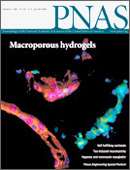Bioengineers create stable networks of blood vessels

Yale biomedical engineers have created an implantable system that can form and stabilize a functional network of fine blood vessels critical for supporting tissues in the body, according to a report in the Proceedings of the National Academy of Sciences.
For body tissue to survive it must receive oxygen delivered through the finest of blood vessels. Led by Erin Lavik, assistant professor of Biomedical Engineering, this study shows that the fine network of blood vessels can be formed. Further, detailed microscopic studies showed that the vascular networks were stable as implants for up to six weeks and were able to connect with larger blood vessel structures.
"This expands our understanding of the neuro-vascular niche and opens up ways to address repair of severed nerves," said Joseph Madri professor of pathology at Yale School of Medicine and a co-author. "We can now study what affects the attraction and repulsion of nerve growth and drug delivery in a model system that can be used in vitro and in vivo."
The researchers used two important engineering enhancements to develop stable functional microcirculation. First, they created a "micro-scaffold" of a macroporous hydrogel polymer. The hydrogel is a three-dimensional, sponge-like material -- highly water-saturable, with a structure of connected pores for cells to grow on and through.
Second, they seeded the hydrogel scaffolds with endothelial cells that make up blood vessel structure along with nerve progenitor cells from the brain. Because there is often an association of nerve connections with vascular networks, they tested to see if a combination of the blood vessel-forming and nerve-forming cells would enhance development of the vascular networks.
"By their nature, hydrogels are well suited for the transport of soluble factors, nutrients or drugs, and waste," said Lavik. "The hydrogel scaffold materials are generally highly biocompatible and safe to implant due to the presence of large volumes of water."
Source: Yale University















